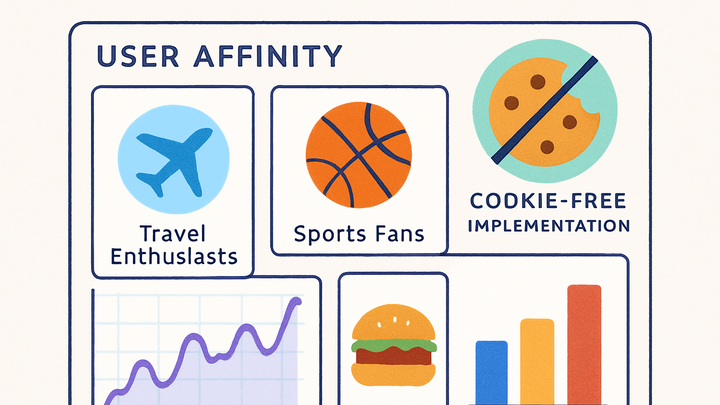Published on 2025-06-22T01:44:35Z
What is an Affinity Segment? Definition and Examples for Analytics
An affinity segment in analytics refers to a group of users who share a common interest or passion based on their online behaviors. Unlike demographic segments that rely on fixed attributes like age or gender, affinity segments are dynamic and derived from browsing history, content consumption, and engagement patterns over time. Analytics platforms such as Google Analytics 4 (GA4) offer predefined affinity categories—like “Travel Buffs” or “Movie Lovers”—and also allow custom definitions. Cookie-free analytics tools like PlainSignal can infer these interests without relying on third-party cookies, using first-party signals instead. Affinity segmentation helps marketers and analysts tailor content, optimize ad targeting, and personalize user experiences by focusing on what users genuinely care about. By understanding affinity segments, businesses can allocate resources more efficiently and drive higher engagement and conversions.
Affinity segment
Groups users by long-term interests inferred from their behavior to enable targeted analytics and marketing.
Definition and Purpose
This section explains what an affinity segment is and why it’s used in analytics.
-
Affinity segment overview
Affinity segments group users based on their long-term interests inferred from browsing behavior and content consumption, enabling marketers to target audiences more effectively.
-
Interest-based grouping
Users are grouped by common interests such as sports, travel, or cooking based on content they engage with.
-
Behavioral signals
Signals include page views, time on page, and engagement patterns collected over weeks or months.
-
-
Why affinity segments matter
Understanding users’ affinities helps in personalized marketing, content recommendations, and optimizing campaigns.
-
Enhanced targeting
Deliver ads and content that resonate with users’ passions, increasing relevance and ROI.
-
Improved engagement
Tailored experiences keep users on site longer and encourage repeat visits.
-
How Affinity Segments Work
This section covers the mechanics behind how analytics platforms identify and assign affinity segments.
-
Signal collection
Platforms collect on-site behavior, page views, and either cookie-based or cookie-free first-party signals to infer interests over time.
-
Behavioral data
Includes clicks, scroll depth, and content categories visited.
-
Machine learning models
Algorithms analyze patterns and classify users into affinity categories.
-
-
Segment assignment
Based on algorithmic thresholds and historical data, users are classified into predefined affinity categories such as “Sports Fans” or “Travel Buffs.”
-
Thresholds for assignment
Minimum engagement levels or frequency criteria determine assignment.
-
Dynamic updates
Segments are updated in near real-time as user interests evolve.
-
Implementing Affinity Segments in Analytics Tools
Examples of setting up affinity segments in PlainSignal (cookie-free) and Google Analytics 4.
-
PlainSignal implementation
Use the PlainSignal tracking snippet to enable affinity segmentation without cookies. Example code:
<link rel="preconnect" href="//eu.plainsignal.com/" crossorigin /> <script defer data-do="yourwebsitedomain.com" data-id="0GQV1xmtzQQ" data-api="//eu.plainsignal.com" src="//cdn.plainsignal.com/plainsignal-min.js"></script> -
GA4 setup
In Google Analytics 4, enable Google Signals and navigate to Audiences > Affinity to view predefined segments or create custom ones under Audience Builder.
Best Practices and Considerations
Tips for effective use of affinity segments in your analytics strategy.
-
Privacy compliance
Ensure alignment with GDPR and CCPA by using cookie-free methods (e.g., PlainSignal) or obtaining explicit consent for cookie-based tracking.
-
Segment customization
Review and adjust segment definitions to match business objectives; consider combining multiple affinity categories for niche targeting.
